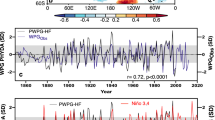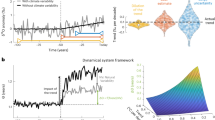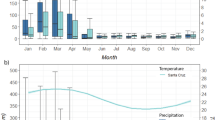Abstract
Since the 1950s, research stations on the Antarctic Peninsula have recorded some of the largest increases in near-surface air temperature in the Southern Hemisphere1. This warming has contributed to the regional retreat of glaciers2, disintegration of floating ice shelves3 and a ‘greening’ through the expansion in range of various flora4. Several interlinked processes have been suggested as contributing to the warming, including stratospheric ozone depletion5, local sea-ice loss6, an increase in westerly winds5,7, and changes in the strength and location of low–high-latitude atmospheric teleconnections8,9. Here we use a stacked temperature record to show an absence of regional warming since the late 1990s. The annual mean temperature has decreased at a statistically significant rate, with the most rapid cooling during the Austral summer. Temperatures have decreased as a consequence of a greater frequency of cold, east-to-southeasterly winds, resulting from more cyclonic conditions in the northern Weddell Sea associated with a strengthening mid-latitude jet. These circulation changes have also increased the advection of sea ice towards the east coast of the peninsula, amplifying their effects. Our findings cover only 1% of the Antarctic continent and emphasize that decadal temperature changes in this region are not primarily associated with the drivers of global temperature change but, rather, reflect the extreme natural internal variability of the regional atmospheric circulation.
This is a preview of subscription content, access via your institution
Access options
Subscribe to this journal
Receive 51 print issues and online access
$199.00 per year
only $3.90 per issue
Buy this article
- Purchase on Springer Link
- Instant access to full article PDF
Prices may be subject to local taxes which are calculated during checkout




Similar content being viewed by others
References
Turner, J. et al. Antarctic climate change during the last 50 years. Int. J. Climatol. 25, 279–294 (2005)
Cook, A. J., Fox, A. J., Vaughan, D. G. & Ferrigno, J. G. Retreating glacier fronts on the Antarctic Peninsula over the past half-century. Science 308, 541–544 (2005)
Vaughan, D. G. Implications of the break-up of Wordie Ice Shelf, Antarctica for sea level. Antarct. Sci. 5, 403–408 (1993)
Convey, P. in Antarctic Peninsula Climate Variability: Historical and Palaeoenvironmental Perspectives (eds Domack, E. et al.) 145–158 (American Geophysical Union, 2003)
Thompson, D. W. J. & Solomon, S. Interpretation of recent Southern Hemisphere climate change. Science 296, 895–899 (2002)
Turner, J., Maksym, T., Phillips, T., Marshall, G. J. & Meredith, M. P. Impact of changes in sea ice advance on the large winter warming on the western Antarctic Peninsula. Int. J. Climatol. 33, 852–861 (2013)
Marshall, G. J., Orr, A., van Lipzig, N. P. M. & King, J. C. The impact of a changing Southern Hemisphere Annular Mode on Antarctic Peninsula summer temperatures. J. Clim. 19, 5388–5404 (2006)
Ding, Q., Steig, E. J., Battisti, D. S. & Kuttel, M. Winter warming in West Antarctica caused by central tropical Pacific warming. Nature Geosci. 4, 398–403 (2011)
Clem, K. R. & Fogt, R. L. Varying roles of ENSO and SAM on the Antarctic Peninsula climate in austral spring. J. Geophys. Res. Atmos. 118, 11481–11492 (2013)
Brohan, P., Kennedy, J. J., Harris, I., Tett, S. F. B. & Jones, P. D. Uncertainty estimates in regional and global observed temperature changes: a new data set from 1850. J. Geophys. Res. Atmos. 111, D12106 (2006)
Screen, J. A. & Simmonds, I. The central role of diminishing sea ice in recent Arctic temperature amplification. Nature 464, 1334–1337 (2010)
Vaughan, D. G. et al. Recent rapid regional climate warming on the Antarctic Peninsula. Clim. Change 60, 243–274 (2003)
Bromwich, D. H. et al. Central West Antarctica among the most rapidly warming regions on Earth. Nature Geosci. 6, 139–145 (2013)
Connolley, W. M. Variability in annual mean circulation in southern high latitudes. Clim. Dyn. 13, 745–756 (1997)
Trenberth, K. E., Fasullo, J. T., Branstator, G. & Phillips, A. S. Seasonal aspects of the recent pause in surface warming. Nature Clim. Chang. 4, 911–916 (2014)
Li, X. C., Holland, D. M., Gerber, E. P. & Yoo, C. Impacts of the north and tropical Atlantic Ocean on the Antarctic Peninsula and sea ice. Nature 505, 538–542 (2014)
Carrasco, J. F. Decadal changes in the near-surface air temperature in the western side of the Antarctic Peninsula. Atmos. Clim. Sci 3, 275–281 (2013)
Gillett, N. P. et al. Attribution of polar warming to human influence. Nature Geosci. 1, 750–754 (2009)
Bals-Elsholz, T. M. et al. The wintertime Southern Hemisphere split jet: structure, variability, and evolution. J. Clim. 14, 4191–4215 (2001)
Turner, J. The El Niño-Southern Oscillation and Antarctica. Int. J. Climatol. 24, 1–31 (2004)
Chen, B., Smith, S. R. & Bromwich, D. H. Evolution of the tropospheric split jet over the South Pacific Ocean during the 1986–89 ENSO cycle. Mon. Weath. Rev. 124, 1711–1731 (1996)
Lorenz, D. J. & Hartmann, D. L. Eddy-zonal flow feedback in the Northern Hemisphere winter. J. Clim. 16, 1212–1227 (2003)
Plumb, R. A. On the 3-dimensional propagation of stationary waves. J. Atmos. Sci. 42, 217–229 (1985)
Fyfe, J. C. et al. Making sense of the early-2000s warming slowdown. Nature Clim. Chang. 6, 224–228 (2016)
Trenberth, K. E. Has there been a hiatus ? Science 349, 691–692 (2015)
Mulvaney, R. et al. Recent Antarctic Peninsula warming relative to Holocene climate and ice-shelf history. Nature 489, 141–144 (2012)
Thomas, E. R., Bracegirdle, T. J., Turner, J. & Wolff, E. W. A 308 year record of climate variability in West Antarctica. Geophys. Res. Lett. 40, 5492–5496 (2013)
Ludescher, J., Bunde, A., Franzke, C. L. E. & Schellnhuber, H. J. Long-term persistence enhances uncertainty about anthropogenic warming of Antarctica. Clim. Dyn. 46, 263–271 (2016)
Turner, J., Hosking, J. S., Marshall, G. J., Phillips, T. & Bracegirdle, T. J. Antarctic sea ice increase consistent with intrinsic variability of the Amundsen Sea Low. Clim. Dyn. 46, 2391–2402 (2016)
Bracegirdle, T. J., Connolley, W. M. & Turner, J. Antarctic climate change over the Twenty First Century. J. Geophys. Res. 113, D03103 (2008)
Turner, J. et al. The SCAR READER project: towards a high-quality database of mean Antarctic meteorological observations. J. Clim. 17, 2890–2898 (2004)
Ding, Q. H. & Steig, E. J. Temperature change on the Antarctic Peninsula linked to the tropical Pacific. J. Clim. 26, 7570–7585 (2013)
Bracegirdle, T. J. & Marshall, G. J. The reliability of Antarctic tropospheric pressure and temperature in the latest global reanalyses. J. Clim. 25, 7138–7146 (2012)
Comiso, J. C. Variability and trends in Antarctic surface temperatures from in situ and satellite infrared measurements. J. Clim. 13, 1674–1696 (2000)
Mann, H. B. Non parametric test against trend. Econometric 13, 245–259 (1945)
Gerstengarbe, F. W. & Werner, P. C. Estimation of the beginning and end of recurrent events within a climate regime. Clim. Res. 11, 97–107 (1999)
Li, Y., Lu, H., Jarvis, M. J., Clilverd, M. A. & Bates, B. Nonlinear and nonstationary influences of geomagnetic activity on the winter North Atlantic Oscillation. J. Geophys. Res. Atmos. 116, D16109 (2011)
Burkey, J. A non-parametric monotonic trend test computing Mann-Kendall Tau, Tau-b, and Sens Slope written in MathWorks MATLAB (King County, Department of Natural Resources and Parks, Science and Technical Services section, 2006)
Santer, B. D. et al. Statistical significance of trends and trend differences in layer-average atmospheric temperature time series. J. Geophys. Res. 105, 7337–7356 (2000)
Marshall, G. J. Trends in the Southern Annular Mode from observations and reanalyses. J. Clim. 16, 4134–4143 (2003)
Acknowledgements
This work was financially supported by the UK Natural Environment Research Council under grant NE/K00445X/1. It forms part of the Polar Science for Planet Earth programme of the British Antarctic Survey. We are grateful to D. G. Vaughan for valuable discussions during this study. We are grateful to ECMWF for the provision of reanalysis fields and to the US National Snow and Ice Data Center for the sea-ice data. The data used in this study are available from the authors upon request.
Author information
Authors and Affiliations
Contributions
J.T. conceived the study and led the writing of the manuscript. J.T., H.L., T.P., J.S.H., G.J.M., T.J.B. and J.C.K. analysed the results. P.D. investigated the role of tropical forcing. T.P. managed the data and prepared some of the figures. H.L. carried out the statistical analysis. R.M. compared the recent trends with palaeoclimate data. I.W. computed the stationary eddy fluxes.
Corresponding author
Ethics declarations
Competing interests
The authors declare no competing financial interests.
Additional information
Reviewer Information Nature thanks W. Hobbs and E. Steig for their contribution to the peer review of this work.
Extended data figures and tables
Extended Data Figure 1 The Southern Annular Mode.
The austral summer (December–February) SAM index40 for December 1979–February 2014. The linear trends for 1980–1997 and 1999–2014 are shown in red. The data were obtained from https://legacy.bas.ac.uk/met/gjma/sam.html.
Extended Data Figure 2 Seasonal SLP trends during the warming period.
a–d, DJF December 1979–February 1998 (a), MAM 1979–1997 (b), JJA 1979–1997 (c) and September–November (SON) 1979–1997 (d). Areas where the trends are significant at P < 0.05 are indicated by a bold line.
Extended Data Figure 3 Seasonal trends in sea-ice concentration during the warming period.
a–d, DJF December 1979–February 1998 (a), MAM 1979–1997 (b), JJA 1979– 1997 (c) and SON 1979–1997 (d). Areas where the trends are significant at P < 0.05 are indicated by a bold line.
Extended Data Figure 4 Seasonal SLP trends during the cooling period.
a–d, DJF December 1999–February 2014 (a), MAM 1999–2014 (b), JJA 1999–2014 (c) and SON 1999–2014 (d). Areas where the trends are significant at P < 0.05 are indicated by a bold line.
Extended Data Figure 5 Seasonal trends in sea-ice concentration during the cooling period.
a–d, DJF December 1999–February 2014 (a), MAM 1999–2014 (b), JJA 1999–2014 (c) and SON 1999–2014 (d). Areas where the trends are significant at P < 0.05 are indicated by a bold line.
Extended Data Figure 6 The correlation of annual mean SAT from the stations with annual mean SLP for 1979–2014.
a–f, Areas where the correlation is significant at P < 0.05 are indicated by a bold line. Rothera (a), Vernadsky (b), Bellingshausen (c), O’Higgins (d), Esperanza (e) and Marambio (f).
Source data
Rights and permissions
About this article
Cite this article
Turner, J., Lu, H., White, I. et al. Absence of 21st century warming on Antarctic Peninsula consistent with natural variability. Nature 535, 411–415 (2016). https://doi.org/10.1038/nature18645
Received:
Accepted:
Published:
Issue Date:
DOI: https://doi.org/10.1038/nature18645
This article is cited by
-
Warming-induced hydrothermal anomaly over the Earth’s three Poles amplifies concurrent extremes in 2022
npj Climate and Atmospheric Science (2024)
-
Evaluation of trends and analysis of air temperature and wind on the Antarctic Peninsula using extreme value theory
Theoretical and Applied Climatology (2024)
-
Investigating non-fungal eukaryotic diversity in snow in the Antarctic Peninsula region using DNA metabarcoding
Extremophiles (2024)
-
Spatial structuring in early life stage fish diversity in the Scotia Sea region of the Southern Ocean
Polar Biology (2024)
-
Surface warming from altitudinal and latitudinal amplification over Antarctica since the International Geophysical Year
Scientific Reports (2023)
Comments
By submitting a comment you agree to abide by our Terms and Community Guidelines. If you find something abusive or that does not comply with our terms or guidelines please flag it as inappropriate.



